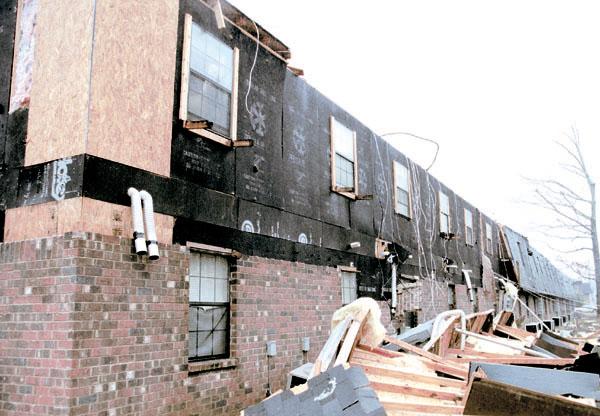In a matter of 15 minutes, several thousand buildings sustained damage on Mississippi State University’s campus and in the Starkville area one year ago Saturday. Saturday, Feb. 16, 2002, celebrates the one year anniversary of the high velocity winds that pushed through the area and twisted everything in their path.
During last year’s storm, winds exceeded 110 mph according to Michael Brown, director of North Mississippi Severe Storm Intercept Team and associate professor of geosciences. Damage totals were first thought to be around $3 million, but later doubled to $6 million after inspection by state and national officials.
The storm formed with very little warning to the public. A tornado watch was put in effect for the Golden Triangle Area which signified that tornado or tornado-like conditions were possible.
Around 12:45 p.m., the National Weather Service office in Jackson issued a severe thunderstorm watch for Oktibbeha County; however later around 1:20 p.m., the office upgraded to a tornado warning, which means a tornado was spotted by weather radars or a spotter.
At 1:30 p.m., MSU classes were finishing up as the storm approached from the south. Around 1:45 the storm hit the MSU campus and Starkville area.
Within 15 minutes, automobile windows had been blow out, trees had fallen and several buildings had sustained major damage. The MSU campus sustained the most damage of the Starkville area.
Initial estimates put the university’s damage amount at $5 million. McComas Hall sustained the most structural damage on campus when parts of its roof and walkway had been blown off. The basement also sustained water damage from the flooding rains. The Wise Center also had roof damage and lost its front entrance sign. The Cooley Building, which houses the physical plant, sustained extensive water damage. The forest products laboratory suffered large amounts of water damage that caused some of the ceilings to fall in from the weight of the water. Students of Suttle and Rice residence halls had their automobiles damaged. Vehicle windows were blown out from the storm or trees and branches that fell on the student’s vehicles.
The largest loss for MSU was at the Raspet Flight Laboratory. Losses included $10,000 in radio equipment, the control tower and an airplane hangar. WMSV, MSU’s radio station lost its transmitting tower on Oktoc Road.
The city of Starkville had tremendous losses as well. Starkville Academy sustained structural damage. Several buildings of the Grove Apartments lost their roofs during the winds. Several business signs were damaged along Miss. Highway 25 and Miss. Highway 12. Some signs were completely lost.
The city damages totaled up to $1.4 million; however, with Mississippi insurance, state and federal aid, the city received $1 million to repair damages..
The storm came without warning causing panic among some students.
“I was in the Union eating a wholesome lunch with a friend,” Lee Hamilton, senior broadcast meteorology major, said. “Since the storm I feel scared about thunderstorms in general.”
Another student, geography major, Josh Branch said, “I was in my apartment looking out my front window watching stuff fly around.”
“I remember that a friend and I were going to go to WalMart,” Susan Robertson, junior marketing major, said. “However, we were stopped as we headed out the door by my roommates who had just come in from unsuccessfully trying to start one of their cars. Had it not been for them coming in just then, we would have been out on the road caught up in the middle of the storm.”
After the storm passed, city and MSU officials started the grim task of searching through the damage and rubble. City officials also had to reevaluate the warning systems, which did not function correctly to warn residents of the coming storm.
“The element of surprise that delayed warnings last February resulted from loss of a warning tower in Choctaw County that was integral part of the communication system,” Mayor Mack Rutledge said.
“I feel that this storm has better prepared us because it shows the gaps in our communication breakdown from that day,” Chris Whited, senior broadcast meteorology major, said.
According to Rutledge, prior to the Feb. 16 storm, the city of Starkville, was planning to replace the obsolete and inadequate outdoor warning system that deteriorated over a period of years. The system, even at its best, would not have extended to the large areas that were annexed in 1994 and 1998.
“In the interest of frugality, the mayor and Board of Aldermen had intended to expand the system in increments, with available funds,” Rutledge said. “In the wake of the storm, it became evident that the entire city should be covered by a modern, functional system of warning.”
In the 2002 city budget, the mayor and board included funding for 12 new sirens to cover the entire city. These sirens were delivered and installation is in progress. The cost of the sirens will be approximately $180,000.
Since the storm, the MSU climate lab has made some improvements of its own to better prepare for anything that might come. The lab has Baron NexRAD services, which provides up to street-level detail of severe thunderstorms. The radar gives wind velocities and hail profiles as well.
“We now have eight state of the art silicon graphics machines for weather analysis,” Brown said. “We have added an unlisted phone line for communication purposes with the university and city.”
“The university police do tend to stay in closer contact with us (NOMISSIT) when severe weather is possible,” climate lab coordinator Tim Wallace said. “You can also say that our students have been more active with regards to NOMISSIT. We have had several people take and pass the ham (the nickname for amateur radio) radio test so that they can better communicate with the climate lab while in the field.”
“The city of Starkville and MSU have been in close communication on this matter, as in all matters of mutual concern,” Rutledge said. “MSU funded the purchase of two sirens in addition to the city’s 12, to be incorporated into a joint system of warning.”
The clean-up from the storm has been quick and productive. Most of the city’s businesses have returned to normal operating potential in the last year.
NOMISSIT and the MSU climate lab have introduced many measures to help prepare the local schools for future warnings.
“The lab provides speakers to schools for severe weather education,” Brown said. “We purchased and donated 18 NOAA (National Oceaneanic and Atmospheric Administration) weather radios to schools across the city and county so that schools can be warned.”
Brown went on to say that more schools need NOAA weather radios so that a full system of warning can be set up.
Rutledge expects the city planners to work more closely with Federal Emergency Management Administration, Mississippi Emergency Management Administration and the American Red Cross during times of recovery and rebuilding.
“The new outdoor warning system should be in place within 30 to 60 days, providing dimensions of warning in both the city and on the campus,” Rutledge said.
Privately owned NOAA weather radios, television and radio warnings will supplement the outdoor warning system. These broadcasts will advise listeners on appropriate precautions taken when threatening conditions occur.
Brown added that NOMISSIT and the climate lab will continue to give talks to local groups, not just students, and hold storm-spotter training courses for local spotters, law enforcement and the general public.
MSU students remain confident that any weather which comes their way will not change their minds about how to prepare or how they feel about severe weather.
“Generally, I like thunderstorms. They’re just fun to watch,” John Harden, junior chemical engineering major, said. “I wasn’t too happy about the big storm last year because it rained out the baseball game. As long as they don’t keep me from Dudy Noble, I don’t mind them at all.”
“I haven’t better prepared myself since the storm in the least bit,” Andy Wood, junior broadcast meteorology major, said. “I think severe weather events need to come around here more often.”
“Since the storm, I am constantly checking the weather online,” Jennifer Griffith, junior special education major, said. “Whether it be the Weather Channel or other weather sites.
The storm: one year later

one year later
Donate to The Reflector
Your donation will support the student journalists of Mississippi State University. Your contribution will allow us to purchase equipment and cover our annual website hosting costs.























































































